I’m sure most of you have seen my How to Make a Gallon of Mead post as it’s still one of my top posts on the blog! It really makes me happy to think of all of you that I have inspired to go out and make your own delicious mead. It’s so easy and fun to make your own booze!
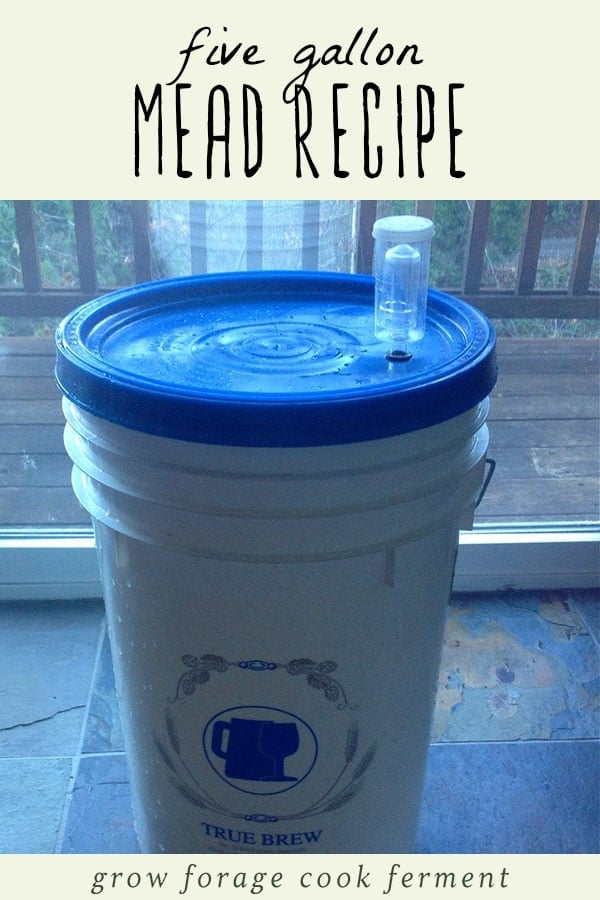
Want to save this post for later?
Want to learn more about making mead? I have a Simple Mead Making for Beginners eBook just for you! It has ingredient and equipment checklists and detailed instructions for brewing and bottling your mead, so be sure to check that out if you’re new to the mead making process.
I would definitely start with only making one gallon of mead, especially if you’re new to brewing or if you’ve never tasted mead before. But, once you get the hang of it and you know that you will actually enjoy the mead that you make (not everyone likes it, strangely enough), it’s time to move on to something a little bigger. Here I will show you how to make 5 gallons of mead!
I actually find this process to be a little easier as you don’t have to mess around with a funnel and narrow necked bottles. You will need some different equipment, making this process a little more expensive, but once you purchase it you can start experimenting with all kinds of brew making!
Supplies & Ingredients for Making 5 Gallons of Mead
First and foremost you will need at least a 6 gallon fermenting vessel. Of course you can go with a traditional carboy if you want, but those tend to be more expensive. I’ve used a food grade plastic bucket with a lid and airlock for years and it’s been great. I actually recommend that you purchase a homebrew kit because it will have everything you need (plus more) for a really good price.
The one that I linked to comes with a fermenter, bottling bucket, sanitizer, large auto siphon, tubing, and bottling tool, all of which are necessary. It also comes with a bottle capper, which isn’t totally necessary for the mead, but is nice to have especially if you are interested in making beer or cider in the future. All in all, it’s a pretty good deal.
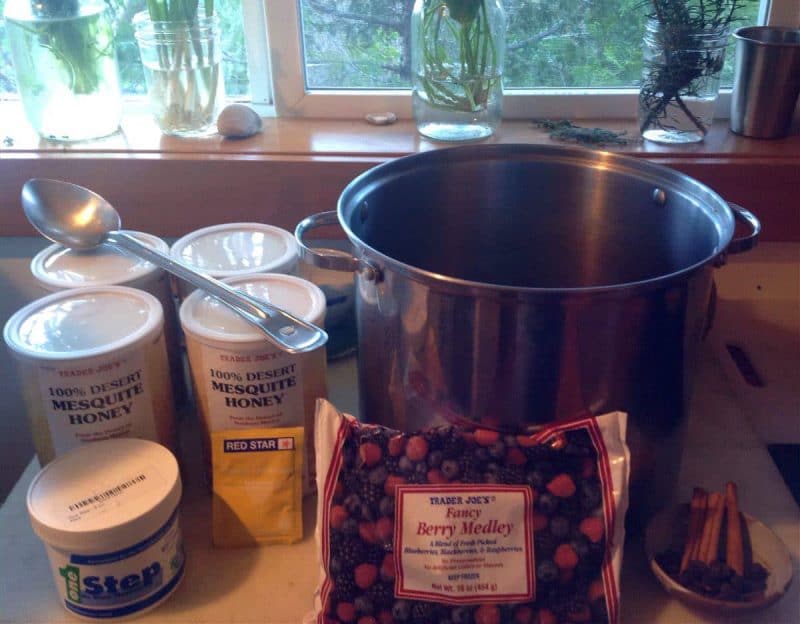
- 12-15 pounds of honey (4-5 quarts), depending on how sweet you want the final product to be
- a large pot
- a big spoon
- sanitizer (it comes with the kit, but if you need to buy it I like One Step)
- 1 package of champagne yeast
- a handful of raisins
- 3 cinnamon sticks (optional)
- fruit of any kind, frozen mixed berries work well (optional)
- orange slices (optional)
How to Make 5 Gallons of Mead
First you will need to sanitize everything, your fermenting bucket and lid, large pot, and big spoon.
Then heat up 2 gallons of water (preferably non chlorinated) in your pot with the cinnamon sticks. You can bring it to a boil to extract more of the cinnamon if you want, but it’s not totally necessary. Just get it nice and hot.
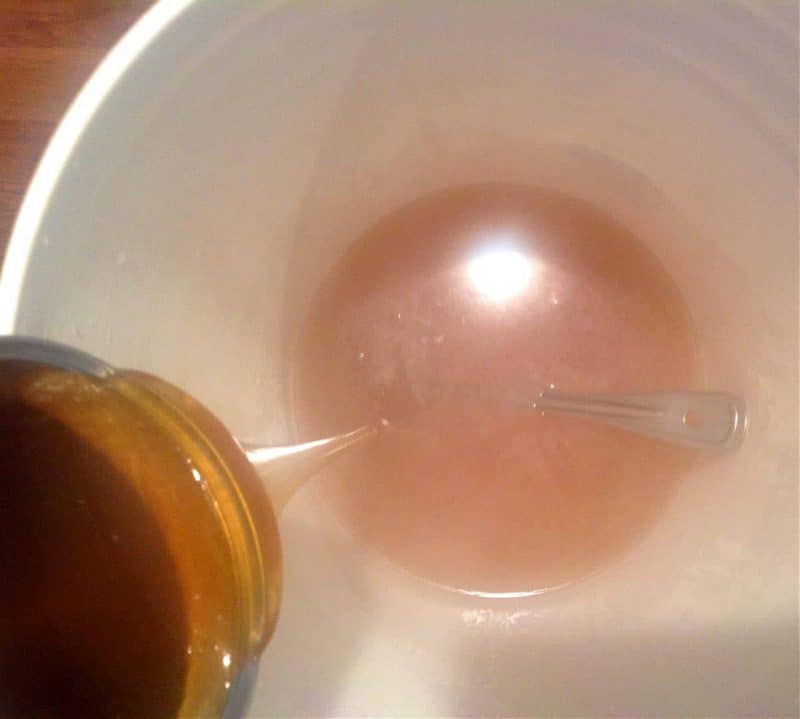
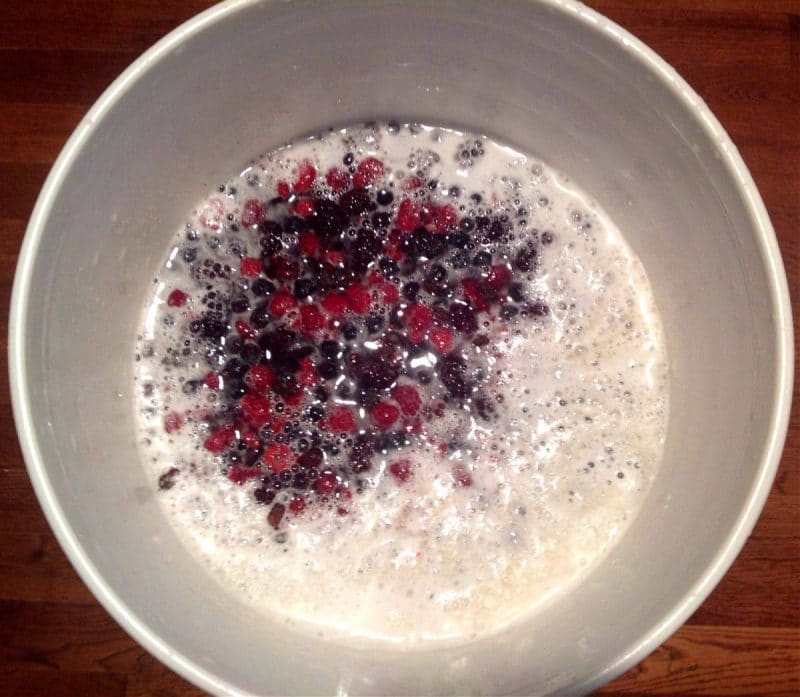
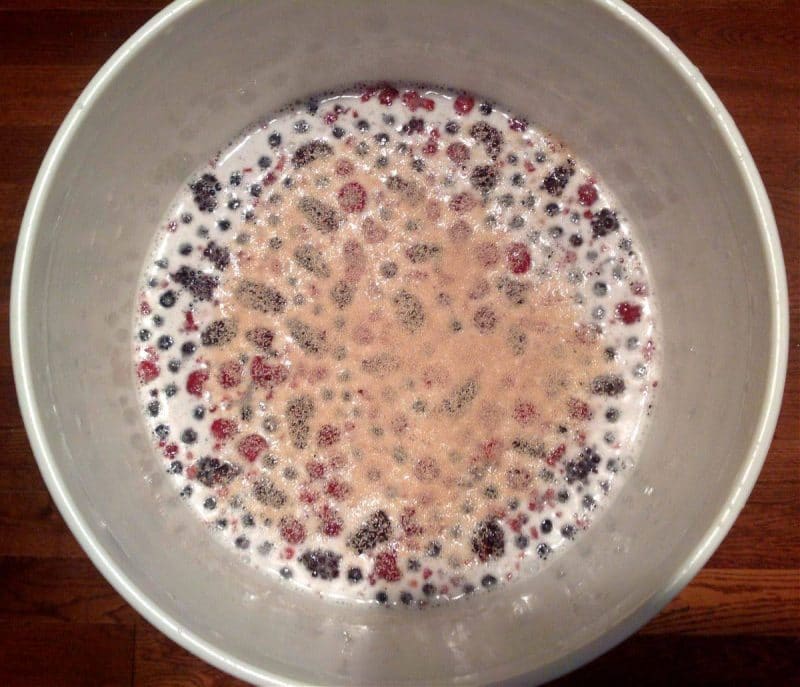
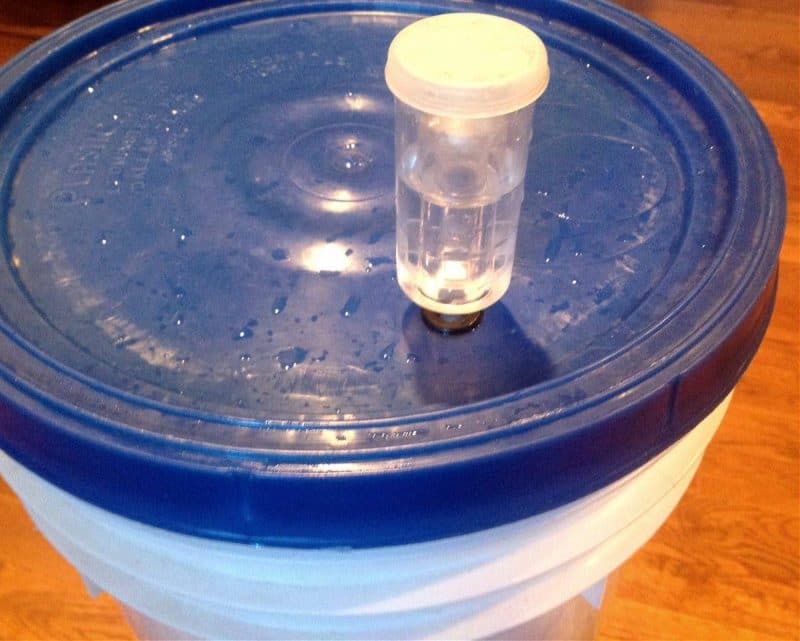
In my experience it takes pretty much a full 6 weeks to completely finish fermenting, possibly a little less time if it’s warm out or a little more if it’s cold. But 6 weeks is usually a good rule of thumb. Tom Petty was right, the waiting is the hardest part!
Once fermentation is complete it’s time to bottle! I show you how to do that in my How to Bottle 5 Gallons of Mead (or wine) post.
Mead Recipes
Ready to start brewing your next batch of mead? Here are 15 mead recipes for you to try including:
Five Gallon Mead Recipe
Equipment
- Bottling Supplies
Ingredients
- 12-15 pounds honey
- 1 package champagne yeast
- handful raisins
- 3 cinnamon sticks optional
- 5 cups fruit of any kind frozen mixed berries work well (optional)
- orange slices optional
Instructions
- Sanitize all equipment that will come in contact with the mead.
- Then heat up 2 gallons of water (preferably non chlorinated) in your pot with the cinnamon sticks. Boil for more cinnamon flavor. If you do boil, let it cool down for a few minutes before the next step.
- Dump the water into your fermenting bucket. Add all of the honey and stir it around with the big spoon to help it dissolve.
- Fill the bucket the rest of the way up to the 5 gallon mark (most fermenting buckets will have marks for each gallon) with cold (non chlorinated) water.
- Stir well, then add your raisins and optional fruit and orange slices.
- Make sure that the temperature of the “must” is 90°F or lower (use a thermometer if you need to), then pitch the yeast. Use the whole packet of yeast and stir well.
- Put the lid on the fermenting bucket, making sure it’s on there very tight as you don’t want any air getting in. Fill your airlock with water to the line and put it in the grommeted hole in the lid.
- Place the bucket in a cool (not cold) place. You should start to see bubbles in the airlock within 24 hours.
- Ferment for 6 weeks.
- Once fermentation is complete, bottle the mead.
Notes
- Learn how to bottle mead in my post How to Bottle 5 Gallons of Mead (or wine).

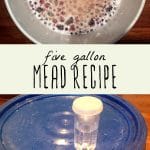
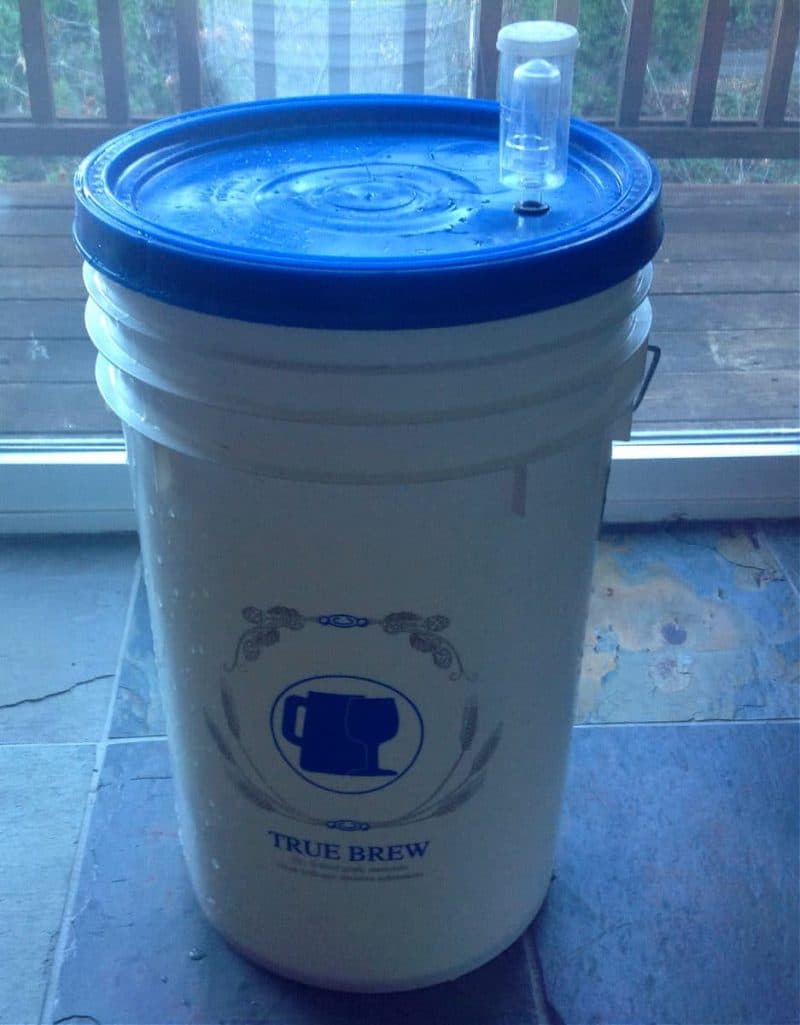
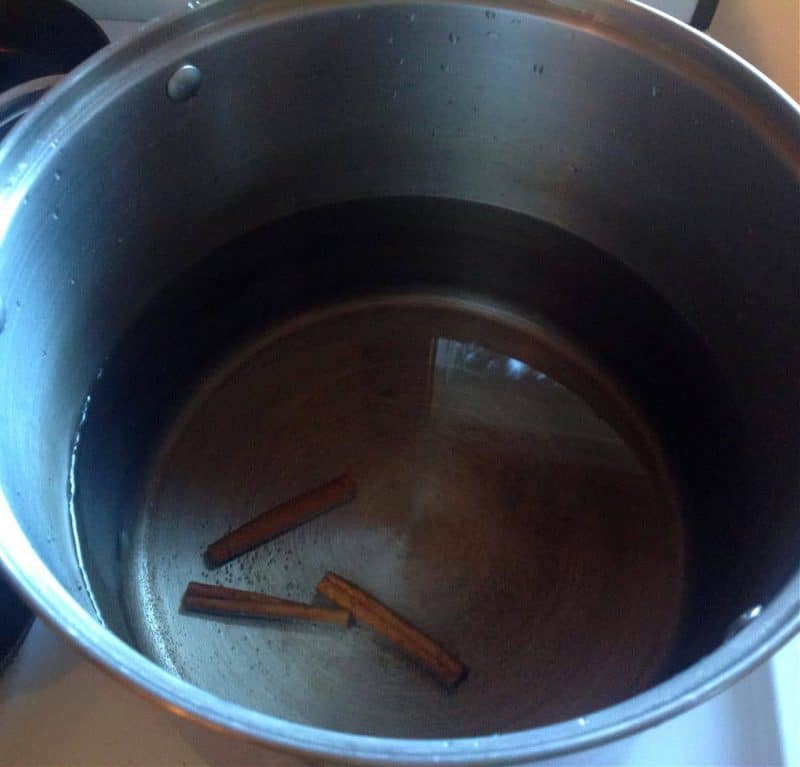
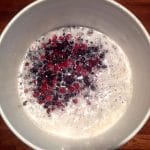

I started my first batch Sunday. I used mandarin oranges, strawberries and limes. When do I need to get the fruit out? I’ve read conflicting ideas… some one week, some two weeks, so leave in the entire time.
I remove the fruit after fermentation stops and before bottling.
HELP. Hi, hope all is going well.
When I started making this mead my honey was crystallized so I added the honey to warm water and dissolved the honey. After I finished filling the 5 gallons I let it set overnight. In the morning some of the honey crystallized again. Can I go ahead and add yeast and let ferment like this. Help what should I do?
Hi Craig. I would be sure that your honey is not crystallized before pitching the yeast. You will need to move your mead to somewhere warmer than 50℉.
Hello. This is a very helpful article. Thank you. I have a question about the yeast. Is it okay to use fresh cake yeast? I live in Belgium and use it regularly. If not, can you help me understand the difference between fresh cake yeast and the champagne yeast noted? Thank you.
Hi Sandra. The reason why bread yeasts aren’t used it in many wine and mead recipes is because they’ll make your finished product taste like bread, whereas, yeasts specifically made for winemaking/mead making can impart more desirable flavor profiles.
I wouldn’t use bread yeast unless you’re in a prison. (ha ha..) I have had EXCELLENT results using a 5 gram (.175 oz.) packet of LALVIN D47 champagne yeast. Well worth the $2.50, to do it right.
My friends were super-impressed with my first ever 5 gallon effort.
Whats the ABV on this before racking ?
Hey there! I’ll be making short mead for the first time, so I’ve got a few questions:
1. What kind of honey is suggested? Raw? Clover?
2. Do you use all 2 gallons of water? Is there a good ratio that can be applied if I brew on a smaller or larger scale?
3. What is the ideal temperature to let the must cool before adding to the fermenting bucket?
4. Can I ferment for a week? What is the minimum amount of time it needs to be fermenting?
5. What would the ABV be after 1 week? 6 weeks?
6. Do I use potassium sorbet if I want to stop the yeast from fermenting if I keg it and store it for a period of time rather than drinking it right away?
What about racking the meade?
Here’s my suggestions:
#1. Use a raw and unfiltered honey. If you’re lucky, you can buy it from a farmer or backyard bee-hive enthusiast, if not, buy from a grocery store. Don’t use cheap, commercial brands, if you want the best quality.
#2. Use SPRING WATER, not distilled or tap water. Most tap water has chlorine and other poisons, and distilled water is void of the nutrients that are beneficial and present in spring water. It’s worth the extra few bucks to buy SPRING WATER.
#3. Let the “concoction” cool to room temperature (65-70 degrees F) before adding and mixing the packet of (hopefully) champagne yeast (Lalvin D47 is my “go-to”). Don’t leave the “must” cooling in an uncovered container, dust and other air-borne contaminants, will only harm your efforts.
#4. “let it ferment for a week”? I hope you were joking, it needs to sit in the (primary) fermenter until the C02 bubbling calms down, perhaps a month or so, at 65 F. degrees, give-or-take a few degrees. (In a dark and constant temperature is best).
After a month or so, siphon the mix into a glass (5 gallon) bottle, with an air-lock to release CO2, but to keep contaminate air from entering )
#5. If you siphon the mix into a secondary bottle (or not), now is the time to BE PATIENT. Give it a few months (7-8 months minimum). The patience on your part will make a BIG difference in the quality.
#6. If you want a carbonated mead, such as a “champagne”, (best option) then add, at most, another 2/3 cups of honey, to “wake-up” the yeast, before bottling, then wait another MONTH (at the very minimum). MEAD will get MUCH better if you store it in a dark 60-65 F environment, for many months (a few years!).
The quality, all depends on how patient you are, in the process..
These are only my (novice) opinions, and I welcome others that agree with my ideas, or not!
Hi Colleen. I am almost set up to try this. Can you tell me, if i let it ferment till it stops wont it be quite dry? Also do you prime in bottle for carbonation and finally how much fruit do you add?
It will take 14+ months to finish fermenting if left to its own devices. I’ve used 7kg of honey in a 5 gallon batch, and it still finished semi-sweet after 14 months and 2 reracks.
But you are right! The best quality takes this long do “do it right”.
Dont bottle it while fermenting unless you use champagne bottles, its like lil bombs in the cupboard, trust me on this or ask my wife after she and the bottles blew up at me. Its much better to drink it after the fermenting. I had mine for 10 thendrank it, fantastic. Its better after at least a year. Thanx Rob
Like you, I learned the hard way too. Bottles blew up, my wife wasn’t happy with my basement mess, but that was decades ago.
If you let it ferment out wont it be quite dry? Also can you give me an idea of how much fruit to use.
Yes it will be on the dry side. I use about one cup of fruit per gallon, so for this recipe about 5 cups of fruit.
It wont have a dry {hot} taste to it if you let it age and mellow for at least a year.
I started my first batch Sunday. I used mandarin oranges, strawberries and limes. When do I need to get the fruit out? I’ve read conflicting ideas… some one week, some two weeks, so leave in the entire time.
I like to rack after fermentation then add fruit. it will start a slight fermentation again, and once that stops I bottle. flavor is sweeter
I am making a 2 gallon and I noted that for 1 gallon you used 1/2 a pack of yeast. For the 5 gallon you used the whole pack of yeast. Is a half pack ok for 2 gallons too? I have 1.5 packs here I just am not sure if 1/2 a pack is enough to add.
This is my second batch. The first one turned out really nice. Blueberry and Lemon. This one is more of a peach Mead with Oranges from Peru Lemon too. I want to try a Mango in the next one.
Thanks Rick M
Half a pack should be fine.
What if I use 5 packs of yeast for 5 gallons? Is that too much?
FIVE packets?! My experience is to use ONE packet of 5gr. (.176 oz.) good quality yeast, specifically for fermenting. (my choice, Lalvin D47).
What would that much yeast do to the fermentation, I’ve never thought of that,
I live in Louisiana and it’s very hot here. I want to try and make strawberry mead. I have a 3 gal bucket that’s is clear bottle with an airlock. How many gallons of water are used for a gallon? Also, I am a home brewer of fruit wines. I usually ferment in the porch buckets in the shade. Does mead have to ferment in ac?
I’ve just finished making the recipe and it’s been sitting for about a week now. Not a lot of bubbling has gone on with my bucket, and I’m concerned. What can I do?? Please, any help is appreciated
Did you add any yeast nutrient? I like to add 1/3 of a tsp for every gallon every day for the first 3 days. This gives the yeast something easier to chew on as the honey takes a little for the yeast to kick in and do it’s thing.
I mix it in very well and it also helps release a lot of the co2 trapped in the mead.
I concur with your opinion,
Mark
Sounds like a good recipe, although, technically, it’s not a mead you are making :) It’s a melomel, but what the heck, if it tastes good, who cares :D
Melomels are in the mead family if honey is used instead of sugar
Great post! I used this as the basis for my first batch of mead that is currently fermenting.
Did you do anything in the way of de-gassing your mead, or did you just leave it alone for 6 weeks?
Thanks!
The details of my batch are below:
12# Bake & Brew Honey – A blend of Titi & Popcorn Honey (https://sleepingbearfarms.com/honey-news/bake-n-brew-honey/)
6# Thawed/Frozen Berries (Blueberry, Raspberry, Blackberry)
2 Whole Oranges Quartered
A Handful of Raisins
White Labs WLP720 Sweet Mead/Wine Yeast
Water filled to 5 Gallons
OG 1.091 (I didn’t take this until after adding the fruit.)
I have two 5gal batches of mead that are 4 weeks into fermentation and they have stopped bubbling. Is it ok to let them sit the last two weeks? Or should I rack and bottle them now? They do have fruit in them.
You should rack as soon as fermentation ends. The sediment at the bottom can be thought of as dead yeast bodies and poo. Why keep your mead exposed to that? Rack it into a similar size glass container and let it continue to settle there. Once it is clear, then bottle. With your yeast no longer active, that fruit in there is just food for other things you don’t want growing. If your yeast is done, the use for your fruit is done.
From my years of experience in brewing many fine beers, there is no downside to letting it rest on the yeast. It actually helps clean up some off flavors.
Ray Roberts here….
I used this basic recipe and I’m very pleased. I did however use 20 lbs the Mead turned out more like a dessert wine.
What purpose do the raisins serve in this recipe? Do they add flavor?
Raisins add tannins and help to feed the yeast.
I tried this recipe and was sure to sanitize everything. It turned out to be very dry so I’m going to have to backsweeten it. But that being said, I think I should have added the orange slices within a week of it ending. The mead has a funky smell to it now (courtesy of the orange fermenting with it no doubt) and I’m not too wild about it. But that being said, it was a great starter mead making tutorial. I know what to do next time.
Yes, if you used the champagne yeast it will be quite dry in the end. You can leave the oranges out next time if it’s not a flavor that you like, or you can also rack the mead into another jug after about a week of fermentation.
The flavor comes through nicely. It’s more the scent of the oranges I dislike. But never the less, it was a great starter recipe. Thanks for giving me the tools to start a new hobby!
I find adding all-natural extract flavorings (they make an orange one) can be nice if you’re interested in backsweetening without feeding residual yeast…we don’t want any bottle bombs. Adding fruit during the process risks bacteria, along with wild (natural) yeast that can create some funky flavors. Extracts give you the control to experiment. Enjoy.
I thought that One Step is a cleaner not a sanitizer? Did you use One Step to sanitize?
It’s a cleaner and mild sanitizer. Feel free to use something stronger if that’s what you prefer.
I use one step in 1 making I use it as As a sanitizer and I’ve had great results
I’ve seen other guides to making mead talk about racking into a secondary ferment-er. In both your guides you omit this step. Why?
It is an optional step, but for the beginning mead maker I find it to be unnecessary. If you let the mead ferment almost completely before you bottle, it will finish in the bottle without the need for a secondary fermenter.
What a great article! Love the pictures
Love,
Reg, Mel, Cindy, Hannah, Jon
P.S. Mel says “Send Mead ASAP”